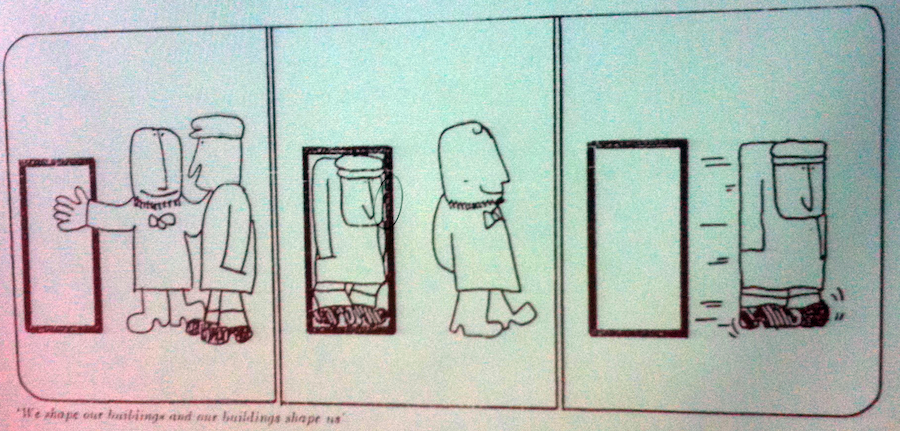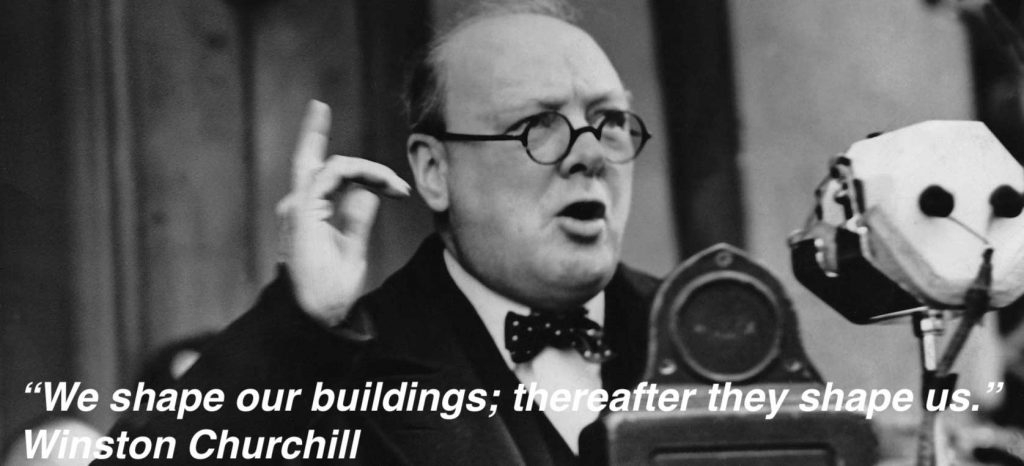“We shape our buildings; thereafter they shape us.” Winston Churchill
The context behind this quote
Winston Churchill’s aphorism “We shape our buildings; thereafter they shape us.” was made during 1943 (28 October) debate about replacing the bombed-out House of Commons chamber. He was adamant about constructing it on the same spot as the old one, despite being much too small for the members of parliament. Churchill was against “giving each member a desk to sit at and a lid to bang” because he argued that overcrowding fostered a much stronger sense of atmosphere and political debate, i.e. and confrontational design helps to keep debates lively and robust but also intimate keeping a “sense of crowd and urgency.” and the House would be empty most of the time. Since then politicians regretted following his advice. Crowded atmosphere works very well for parties but not necessary for confrontational political debates. Feng shui advises against confrontational designs which keep people in fixed mindsets about things.
Full quote:
“On the night of May 10, 1941, with one of the last bombs of the last serious raid, our House of Commons was destroyed by the violence of the enemy, and we have now to consider whether we should build it up again, and how, and when. We shape our buildings, and afterwards our buildings shape us. Having dwelt and served for more than forty years in the late Chamber, and having derived very great pleasure and advantage therefrom, I, naturally, should like to see it restored in all essentials to its old form, convenience and dignity.”
Winston Churchill, London, 28 October 1943
Insights from the quote “We shape our buildings; thereafter they shape us.” by Winston Churchill
There are four insights from Churchill’s statement: 1) bigger is not necessarily better, 2) density creates value, 3) spaces have memory, and 4) we shape our reality
1. Bigger is not always better – sometimes less is more
Whether it is your home or workplace or office bigger is not always better. If you need more space, firstly look at the existing space and evaluate if you need more space or just a more optimised space or other tools to help you to manage what you already have. Look at innovative solutions to maximise the space you have.
2. Density creates value, buzz, creativity and collaboration
The best parties are usually crowded in small spaces which Winston Churchill understood well because they create a buzz and high, intimate interaction. 80/20 rule (Pareto principle) suggests that most homes and offices utilise little space. Office buzz in workplaces is supposed to encourage creativity, cross talk and collaboration. That’s why many companies position kitchens, staircases and bathrooms in centralised, shared spaces. Famously, Steve Jobs used this strategy at Pixar, and the new Apple’s headquarters building in Cupertino is another example.
“Influencing behaviour is almost all of what management is about, and buildings influence behaviour.”
John A Seiler, Architect
3. Space conditioning – spaces have memory
Research from Environmental Psychology and ergonomics suggests that physical features anchors, prime and help us remember things. In offices: ‘shared project wall’, flow charts, notations, diagrams, quotes, images, inspirational poster, remind employees about the values of the company as well as help them to focus on what’s important and deal successfully with interruptions. They also can trigger specific behaviours through memories or legacy or historical artefacts of the company or organisation. In quantum physics, the concept of space conditioning where the actual memories of what happened in a particular setting are stored in the space, similar to the morphic fields is gaining more recognition and echoes intuitive understanding from many cultures.
4. Larger media context – we shape our reality
In the context of the modern world and 21st-century media, Churchill’s quote could be generalised and paraphrased to read like this, “We shape our reality (with our perceptions), thereafter our perceptions of reality shape us.” Recent research into how social media affects and lock people and their behaviours is a good example of this idea. By the time you’re born, your future has been shaped to some extent by your genes, social background, the place you were born, race, when you were born and hundreds of other environmental, social and religious factors.

“We shape our buildings thereafter they shape us.” Winston Churchill
Quotes about buildings, architecture, interior design and feng shui
“Dancing and architecture are the two primary and essential arts. The art of dancing stands at the source of all the arts that express themselves first in the human person. The art of building, or architecture, is the beginning of all the arts that lie outside the person; and in the end they unite.”
Havelock Ellis, The Dance of Life (1923)
“To be a man is to be responsible: to be ashamed of miseries you did not cause; to be proud of your comrades’ victories; to be aware, when setting one stone, that you are building a world.”
Antoine de Saint Exupéry Wind, Sand and Stars,’ (1939), p. 93
“I approach each building as a sculptural object, a spatial container, a space with light and air, a response to context and appropriateness of feeling and spirit. To this container, this sculpture, the user brings his baggage, his program, and interacts with it to accommodate his needs. If he can’t do that, I’ve failed.”
Frank Gehry in Blueprint. Nr. 90-92, 1992
“Terrorist attacks can shake the foundations of our biggest buildings, but they cannot touch the foundation of America. These acts shattered steel, but they cannot dent the steel of American resolve.”
George W. Bush in his “Address to the Nation” (September 11, 2001)
“I read somewhere that the tallest buildings in a town reflect that society’s values; if so, this one screamed that money mattered and beauty didn’t.”
Stephen Dedman, The Devotee, in David G. Hartwell (ed.) Year’s Best SF 6, p. 163 (Originally published in Eidolon magazine, Autumn 2000)
“I do not believe that ever any building was truly great, unless it had mighty masses, vigorous and deep, of shadow mingled with its surface.”
John Ruskin, The Seven Lamps of Architecture (1849), chapter III, paragraph 24
“I knew, as everyone knows, that the easiest way to attract a crowd is to let it be known that at a given time and a given place some one is going to attempt something that in the event of failure will mean sudden death. That’s what attracts us to the man who paints the flagstaff on the tall building, or to the ‘human fly’ who scales the walls of the same building.”
Harry Houdini As quoted in The Life and Many Deaths of Harry Houdini (1993) by Ruth Brandon, p. 153
“There can be little doubt that in many ways the story of bridge building is the story of civilisation. By it we can readily measure an important part of a people’s progress.”
Franklin D Roosevelt, in Kurilpa Bridge, p. 72
“Life is chaotic, dangerous, and surprising. Buildings should reflect that.”
Frank Gehry in Jason K. Miller, Susan Lauzau (2002) Frank Gehry. p. 6
“The world is a house on fire.”
Buddha
“A building has integrity just like a man. And just as seldom.”
Ayn Rand, in Onlogic: Speed and Vision, (2008)
“We require from buildings, as from men, two kinds of goodness: first, the doing their practical duty well: then that they be graceful and pleasing in doing it; which last is itself another form of duty.”
John Ruskin, The Stones of Venice, Volume I, Chapter II
“Better the rudest work that tells a story or records a fact, than the richest without meaning. There should not be a single ornament put upon great civic buildings, without some intellectual intention.”
John Ruskin, Seven Lamps of Architecture, The Lamp of Memory

